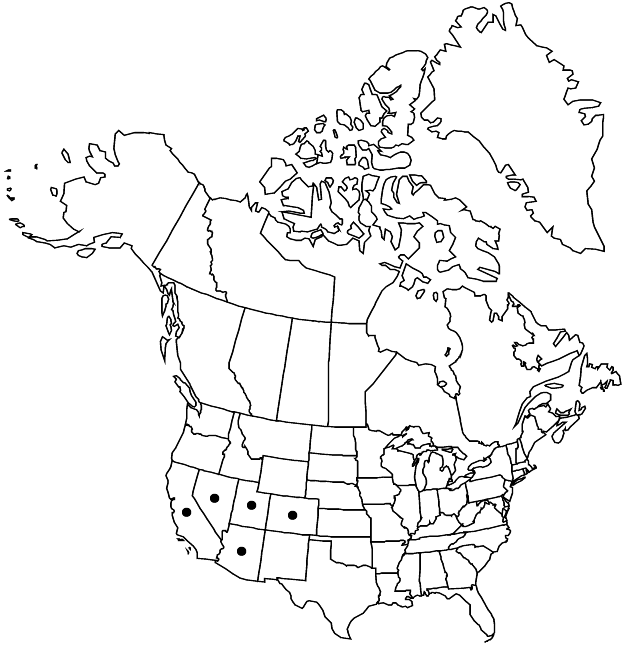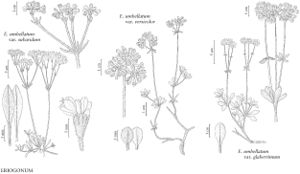Difference between revisions of "Eriogonum umbellatum var. subaridum"
Leafl. W. Bot. 2: 53. 1937.
FNA>Volume Importer |
FNA>Volume Importer |
||
| Line 34: | Line 34: | ||
|distribution=Ariz.;Calif.;Colo.;Nev.;Utah. | |distribution=Ariz.;Calif.;Colo.;Nev.;Utah. | ||
|discussion=<p>Variety subaridum is widespread and often common throughout its extensive range from southeastern California, southern <i>Nevada</i>, and northern Arizona to Utah and southwestern Colorado.</p><!-- | |discussion=<p>Variety subaridum is widespread and often common throughout its extensive range from southeastern California, southern <i>Nevada</i>, and northern Arizona to Utah and southwestern Colorado.</p><!-- | ||
| − | --><p>Variety subaridum is more closely related to <i></i>var.<i> nevadense</i> than it is to <i></i>var.<i> ellipticum</i>. Some populations in southwestern Utah and southwestern Colorado are distinctly shrubby, and around Zion National Park some may even have leaves glabrous on both surfaces by late fruit (e.g., Neese & Neese 9633, BRY; Thorne & Welsh 15194, BRY; Welsh et al. 27166, BRY). Such plants never have leaf blades glabrous at anthesis, as is the case with <i></i>var.<i> chlorothamnus</i>. A few populations in southeastern Utah (e.g., Welsh & Thorne 25091, BRY) have densely tomentose abaxial leaf blades and approach <i></i>var.<i> munzii</i>. The taxonomic significance of those differences remains to be determined.</p> | + | --><p>Variety subaridum is more closely related to <i></i></i>var.<i><i> nevadense</i> than it is to <i></i></i>var.<i><i> ellipticum</i>. Some populations in southwestern Utah and southwestern Colorado are distinctly shrubby, and around Zion National Park some may even have leaves glabrous on both surfaces by late fruit (e.g., Neese & Neese 9633, BRY; Thorne & Welsh 15194, BRY; Welsh et al. 27166, BRY). Such plants never have leaf blades glabrous at anthesis, as is the case with <i></i></i>var.<i><i> chlorothamnus</i>. A few populations in southeastern Utah (e.g., Welsh & Thorne 25091, BRY) have densely tomentose abaxial leaf blades and approach <i></i></i>var.<i><i> munzii</i>. The taxonomic significance of those differences remains to be determined.</p> |
|tables= | |tables= | ||
|references= | |references= | ||
| Line 58: | Line 58: | ||
|publication year=1937 | |publication year=1937 | ||
|special status= | |special status= | ||
| − | |source xml=https://jpend@bitbucket.org/aafc-mbb/fna-data-curation.git/src/ | + | |source xml=https://jpend@bitbucket.org/aafc-mbb/fna-data-curation.git/src/f6b125a955440c0872999024f038d74684f65921/coarse_grained_fna_xml/V5/V5_703.xml |
|subfamily=Polygonaceae subfam. Eriogonoideae | |subfamily=Polygonaceae subfam. Eriogonoideae | ||
|genus=Eriogonum | |genus=Eriogonum | ||
Revision as of 20:09, 24 September 2019
Subshrubs or shrubs, spreading to erect, sometimes round, 2–7 × 3–9(–12) dm. Aerial flowering stems erect, (0.5–)1–3 dm, floccose or glabrous, without one or more leaflike bracts ca. midlength. Leaves in rather loose rosettes; blade elliptic, 1–3 × 0.5–2 cm, thinly floccose on both surfaces or glabrous and green adaxially (glabrous on both surfaces in s Utah, rarely tomentose abaxially in se Utah), margins plane. Inflorescences compound-umbellate, branched 2–5 times; branches floccose or glabrous, without a whorl of bracts ca. midlength; involucral tubes 2–3(–3.5) mm, lobes 1–3 mm. Flowers 3–7 mm; perianth bright yellow.
Phenology: Flowering Jun–Oct.
Habitat: Sandy to gravelly flats and slopes, mixed grassland, saltbush, and sagebrush communities, oak, pinyon-juniper, and montane conifer woodlands
Elevation: 1200-3100 m
Distribution

Ariz., Calif., Colo., Nev., Utah.
Discussion
Variety subaridum is widespread and often common throughout its extensive range from southeastern California, southern Nevada, and northern Arizona to Utah and southwestern Colorado.
Variety subaridum is more closely related to var. nevadense than it is to var. ellipticum. Some populations in southwestern Utah and southwestern Colorado are distinctly shrubby, and around Zion National Park some may even have leaves glabrous on both surfaces by late fruit (e.g., Neese & Neese 9633, BRY; Thorne & Welsh 15194, BRY; Welsh et al. 27166, BRY). Such plants never have leaf blades glabrous at anthesis, as is the case with var. chlorothamnus. A few populations in southeastern Utah (e.g., Welsh & Thorne 25091, BRY) have densely tomentose abaxial leaf blades and approach var. munzii. The taxonomic significance of those differences remains to be determined.
Selected References
None.
